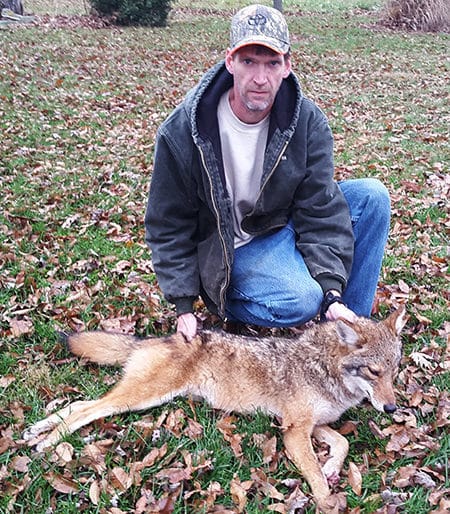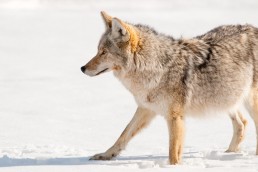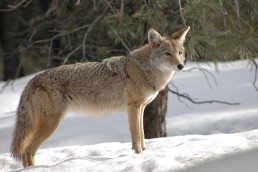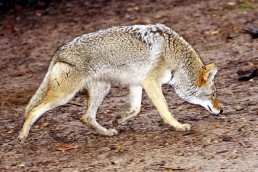Pick the Right Time and Place to put out Coyote Decoys
SHARE THIS POST
Deer and turkey hunters know what kind of impact decoys can have on their hunt if used properly. But what about coyote hunters?
I first had begun to use silhouette coyote decoys when I was a hunting guide out west. Moving back to the Midwest, I bought the tactic back with me, with results that were beyond my highest expectations.
Early in the winter I do not use decoys much. There is a time and place to use silhouette coyote decoys. Late in the fall I don’t use them either very much. I have better luck hunting as many different areas as possible, relying on mouth calls. Early in the season decoys tend to scare more dogs than they bring in.
When January rolls around the young coyotes have matured some, and begin to think they can take on other coyotes—a
decoy then is the ticket to success. Decoys remain productive now through the month of April. A coyote may not always come in charging to a fake, and always ready for a fight, but they will let themselves be seen, normally circling downwind of the decoy.
When choosing a location to hunt, pick an area that allows both you and the coyotes the ability to see long distances without obstructions. These places could be in a draw, halfway up a ridge or on a flat. It is possible to call in coyotes in thick terrain, but decoys are worthless in such places. This is because the coyotes will not be able to see them until they are already in scattergun range.

Two silhouette decoys work best for me. I place the decoys at a 90-degree angle to one another, with only 2 or 3 yards separating the two. Most silhouette decoys come with a picture of a coyote on both sides. Setting my decoys in the position that I do lets them be seen from all directions.
Safety also needs to be practiced when coyote hunting with silhouettes. Make sure you are far from roads when setting up. You do not want a “hunter” pulling off to the side of the road and taking aim on your fake coyotes.
Are you enjoying this post?
You can be among the first to get the latest info on where to go, what to use and how to use it!
Do not rely solely on your decoys to bring in coyotes; you will still have to call.
I use an electric call. This year I switched to the FoxPro Firestorm. The new technology the company introduced in their call is nothing short of amazing: I set the call between the two decoys on the ground, I position myself about 30 yards downwind and offset to the side about 15 yards. I do not want to be directly downwind. That way, a coyote coming in directly downwind of the fake coyote will not be directly downwind of me too. When using mouth-blown calls I get about 10 yards closer to the silhouettes, but still offset the same.
Another trick I like to employ is to saturate some cotton balls in coyote urine and place them on the ground at the decoys. This will not only help hide human odors, but also give off a realistic coyote odor.
I begin my calling regime with lone howls, soft barks or pup howls. I do not want to be aggressive with my calling unless a responding coyote is aggressively coming in, but stops short of being in shotgun range. When this happens I switch to a rabbit distress sound.
As I mentioned earlier the technology with the FoxPro Firestorm is awesome. How often have we had more than one coyote approach our setup? When the first coyote is shot the remaining coyotes could still be called in if we switch call sounds immediately. But, that means the hunter has to reach down and make changes manually. That often results in spooked coyotes and wasted time. With the Firestorm all the work is automatically done for you. When I shoot the closest, most aggressive coyote the call recognizes the blast of the gun, and automatically switches to what I have it programmed to, normally “ki-yi.” The remaining coyotes recognize the call change. However, they do not see any hunter movement because there is none, and they begin to work their way back into shotgun range.
Full-body coyote decoys can be used, but they can be cumbersome to carry, especially for long distances. Two silhouette decoys can easily be folded up and carried easier than just one full-body coyote.
This winter set out a couple of decoys, get downwind, turn on the call and be safe. It is a surefire way to add some fur to the stretchers and put a little money in your pockets.
MWO
SHARE THIS POST
Did you enjoy this post?
You can be among the first to get the latest info on where to go, what to use and how to use it!
Jason Houser
Jason Houser is an avid outdoorsman from Central Illinois. Houser has been a full-time freelance writer since 2008. He is also the host of Jason Houser Outdoors, airing on the Hunt Channel. He can be found on Facebook at Jason Houser Outdoors or on the web at jasonhouseroutdoors.com.



